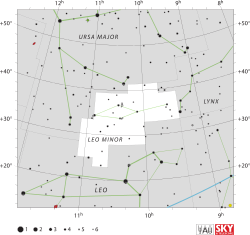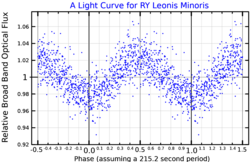G 117-B15A
| G 117-B15A | |
 | |
| Observationsdata Epok: J2000.0 | |
|---|---|
| Stjärnbild | Lilla lejonet |
| Rektascension | 09t 24m 15,25s[1] |
| Deklination | +35° 16′ 51,4 ″[1] |
| Skenbar magnitud () | 15,5[2] |
| Stjärntyp | |
| Spektraltyp | DAV4[3] |
| U–B | -0,6[2] |
| B–V | +0,2[2] |
| Variabeltyp | Pulserande vit dvärg[2] |
| Astrometri | |
| Radialhastighet () | +2,2[4] km/s |
| Egenrörelse (µ) | RA: -145,181[1] mas/år Dek.: -0,053[1] mas/år |
| Parallax () | 17,3947 ± 0,0452[1] |
| Avstånd | 187,5 ± 0,5 lå (57,5 ± 0,1 pc) |
| Absolut magnitud () | +11,79[3] |
| Detaljer | |
| Massa | 0,69[3] M☉ |
| Temperatur | 12 400[5] K |
| Ålder | 400[6] miljoner år |
| Andra beteckningar | |
| G 117-15A, KUG 0921+354, LSPM J0924+3516W, 2MASS J09241526+3516513, PG 0921+355, SDSS J092415.20+351651.4, SDSS J092415.21+351651.4, SDSS J092415.21+351651.3, UCAC4 627-044436, USNO-B1.0 1252-00171660, uvby98 620020065, RY Leonnis Minoris, WDS J09243+3517A, WD 0921+35, WD 0921+354, Gaia DR3 798566915774818176, Gaia DR2 798566915774818176[4][7] | |
G117-B15A[8] är en ensam stjärna i den mellersta delen av stjärnbilden Lilla lejonet och har även variabelbeteckningen RY Leonis Minoris.[9] Den har skenbar magnitud av ca 15,5[2] och kräver ett kraftfullt teleskop för att kunna observeras. Baserat på parallax enligt Gaia Data Release 3 på ca 17,4 mas,[1] beräknas den befinna sig på ett avstånd på ca 188 ljusår (ca 57,5 parsek) från solen. Den rör sig bort från solen med en heliocentrisk radialhastighet på 2 km/s.[4]
Egenskaper
[redigera | redigera wikitext]G117-B15A är en vit dvärgstjärna av spektralklass DAV4.[2] Den har en massa som är ca 0,7[3] solmassa och har en effektiv temperatur av ca 12 400 K.[5] Stjärnan är en källa till röntgenstrålning.[10]

G117-B15A visades 1974 av Richer och Ulrych vara variabel,[11] vilket 1976 bekräftades av McGraw och Robinson.[12] År 1984 visades det att stjärnans variabilitet beror på icke-radiala gravitationsvågpulseringar. Som en konsekvens är dess tidsskala för periodändring direkt proportionell mot dess kylningstidsskala, vilket gör att dess kylningshastighet kan mätas med hjälp av asteroseismologisk teknik.[8] Dess ålder uppskattas till 400 miljoner år.[6] Dess ljuskurva har en dominerande period på 215,2 sekunder,[8] som beräknas öka med ungefär en sekund per 14 miljoner år.[13] G117-B15A har hävdats vara den mest stabila optiska klockan som någonsin hittats, mycket stabilare än tickarna på en atomklocka.[14] Den är också den första pulserande vita dvärgen som har identifierat sitt huvudsakliga pulsationslägesindex.[8]
Referenser
[redigera | redigera wikitext]- Den här artikeln är helt eller delvis baserad på material från engelskspråkiga Wikipedia, G 117-B15A, 3 mars 2023.
Noter
[redigera | redigera wikitext]- ^ [a b c d e f] Vallenari, A.; et al. (Gaia Collaboration) (2022). "Gaia Data Release 3. Summary of the content and survey properties". Astronomy & Astrophysics. arXiv:2208.00211. doi:10.1051/0004-6361/202243940. Gaia DR3 record for this source at VizieR.
- ^ [a b c d e f] McCook, George P.; Sion, Edward M. (March 1999). "A Catalog of Spectroscopically Identified White Dwarfs". Astrophysical Journal Supplement. 121 (1): 1–130. Bibcode:1999ApJS..121....1M. doi:10.1086/313186. S2CID 122286998. CDS ID III/210.
- ^ [a b c d] Gianninas, A.; Bergeron, P.; Ruiz, M. T. (2011). "A Spectroscopic Survey and Analysis of Bright, Hydrogen-rich White Dwarfs". The Astrophysical Journal. 743 (2): 138. arXiv:1109.3171. Bibcode:2011ApJ...743..138G. doi:10.1088/0004-637X/743/2/138. S2CID 119210906.
- ^ [a b c] RY LMi (unistra.fr). Hämtad 2023-06-23.
- ^ [a b] Kepler, S. O.; Winget, D. E.; Vanderbosch, Zachary P.; Castanheira, Barbara Garcia; Hermes, J. J.; Bell, Keaton J.; Mullally, Fergal; Romero, Alejandra D.; Montgomery, M. H.; Degennaro, Steven; Winget, Karen I.; Chandler, Dean; Jeffery, Elizabeth J.; Fritzen, Jamile K.; Williams, Kurtis A.; Chote, Paul; Zola, Staszek (2020). "The Pulsating White Dwarf G117-B15A: Still the Most Stable Optical Clock Known". The Astrophysical Journal. 906 (1): 7. arXiv:2010.16062. Bibcode:2021ApJ...906....7K. doi:10.3847/1538-4357/abc626. S2CID 226222216.
- ^ [a b] Pivetta, Marcos (January 2006). "The star of the moment". Hämtad 2007-06-06.
- ^ "V* RY LMi". SIMBAD. Centre de données astronomiques de Strasbourg. Hämtad 2023-01-30.
- ^ [a b c d] Kepler, S. O.; et al. (2000-05-10). "Evolutionary Timescale of the Pulsating White Dwarf G117-B15A: The Most Stable Optical Clock Known". The Astrophysical Journal Letters. 534 (2): L185–L188. arXiv:astro-ph/0003478. Bibcode:2000ApJ...534L.185K. doi:10.1086/312664. PMID 10813678. S2CID 14540467.
- ^ [a b] Chote, P.; Sullivan, D. J.; Brown, R.; Harrold, S. T.; Winget, D. E.; Chandler, D. W. (May 2014). "Puoko-nui: a flexible high-speed photometric system". Monthly Notices of the Royal Astronomical Society. 440 (2): 1490–1497. doi:10.1093/mnras/stu348.
- ^ Kepler SO (December 5, 2005). "Astronomers Find Most Stable Optical Clock In Heavens".
- ^ High-frequency optical variables. II. Luminosity-variable white dwarfs and maximum entropy spectral analysis, H. B. Richer and T. J. Ulrych, Astrophysical Journal 192 (September 1974), pp. 719–730.
- ^ High-speed photometry of luminosity-variable DA dwarfs: R808, GD 99, and G 117-B15A, J. T. McGraw and E. L. Robinson, Astrophysical Journal 205 (May 1976), pp. L155–L158.
- ^ From Ṗ=2,3·10−15 in Kepler et al.
- ^ McDonald Observatory. "Astronomers Find Most Stable Optical Clock in Heavens; Aids Understanding of Stars' Lives". McDonald Observatory. Hämtad 2007-06-06.




